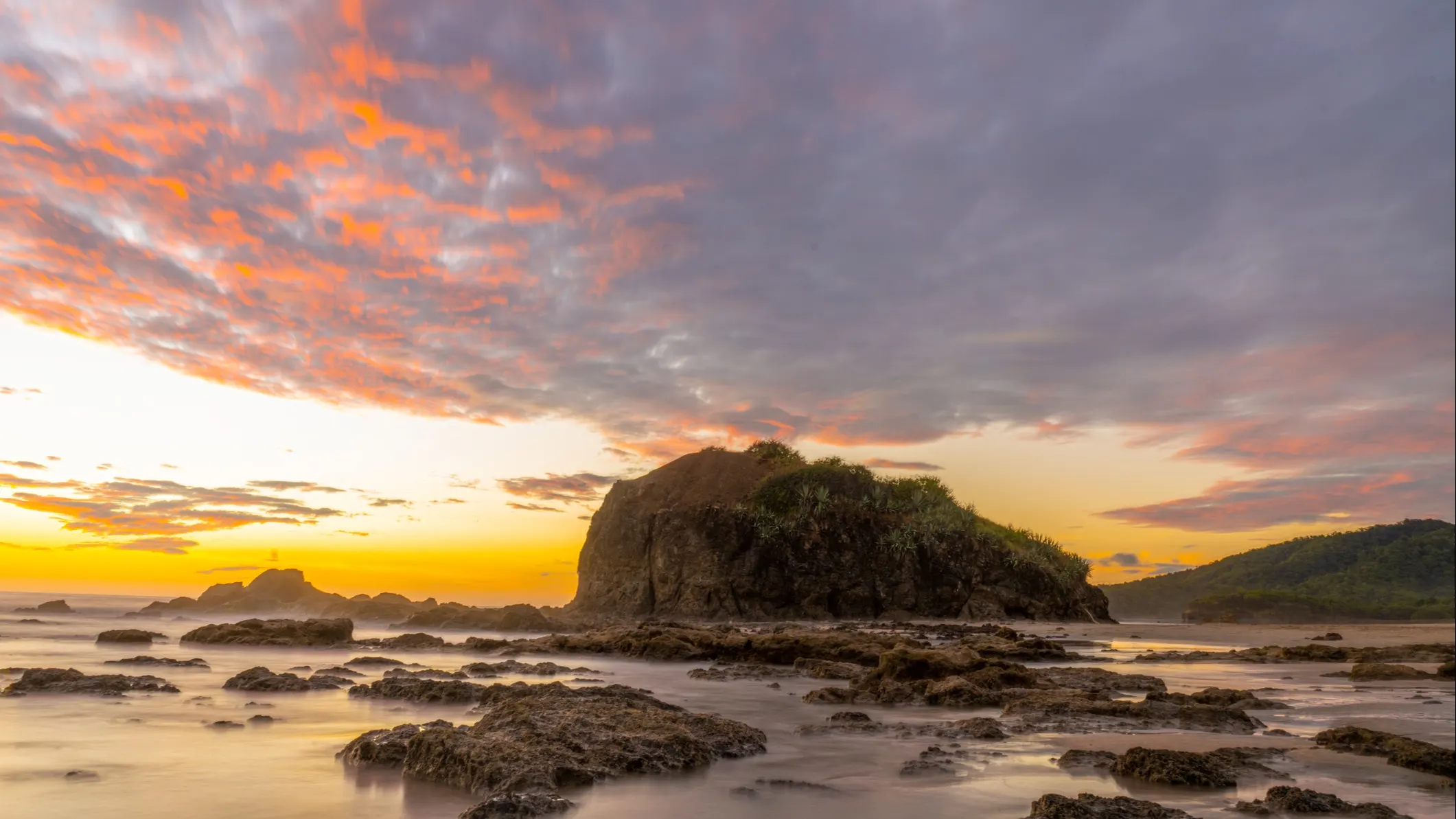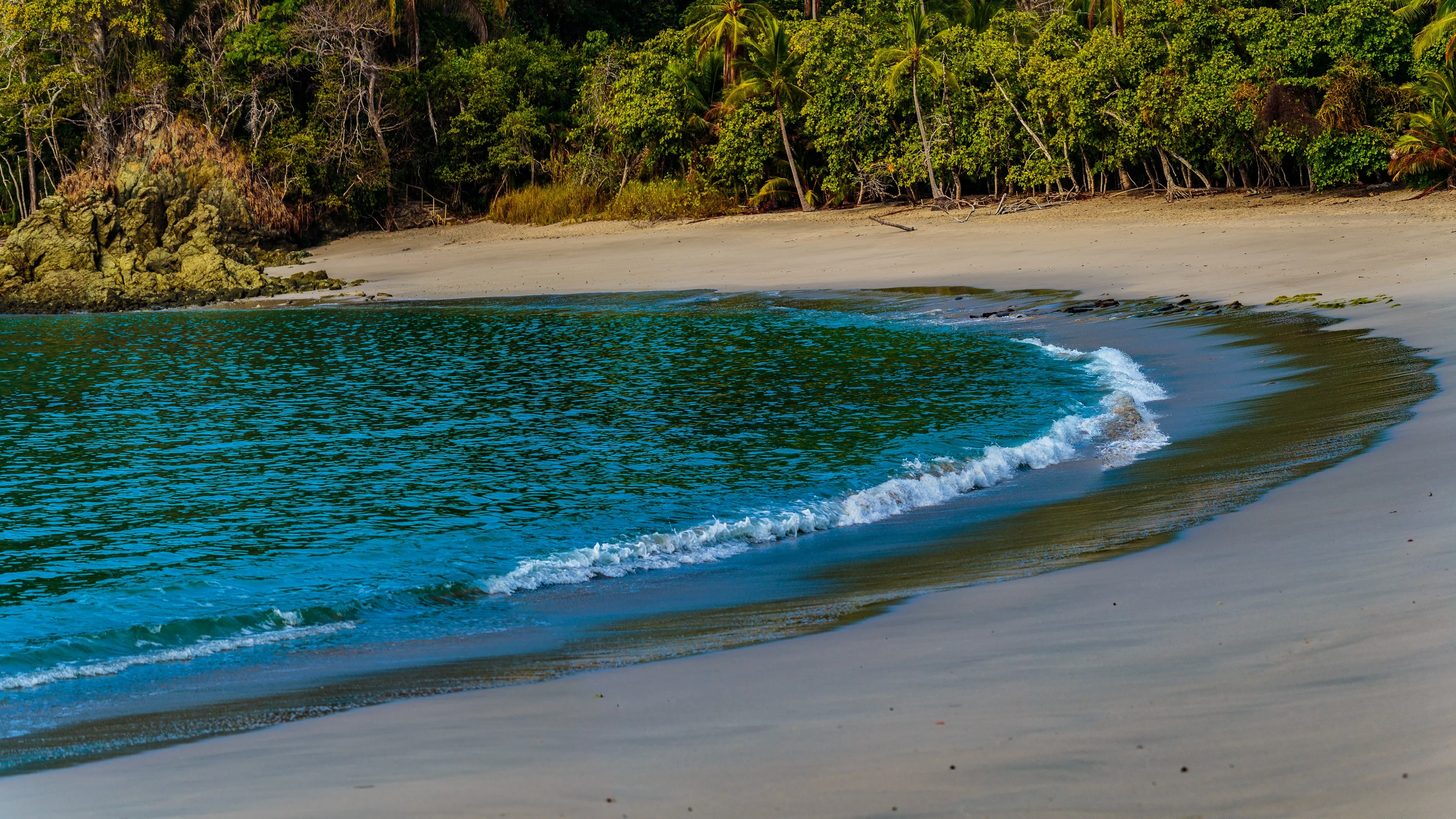Guanacaste is the warmest and driest of Costa Rica’s seven provinces. With a population of about 400,000 people, it covers the whole northwestern section of the country, bordering the Pacific Ocean and the country’s northern neighbor, Nicaragua. It is the most sparsely populated region of Costa Rica, covered in open pasture, protected park land, and tropical dry forest.
Prior to July 25, 1824, the region was part of Nicaragua. Guanacaste’s Annexation happened as a result of the people’s choice, and today people living in this region are known as “Guanacastecos.” The decision to leave Nicaragua and become a part of Costa Rica has long been recognized as a symbol of Costa Rica’s strong democracy, and the people take great pride in celebrating it.
Home to more than 65 of Costa Rica’s nearly 300 beaches—some remote and some the centerpiece of buzzing beach communities—Guanacaste draws expats and international tourists from all corners of the world. Known as Costa Rica’s Gold Coast, not only do the beaches check the boxes of beautiful, safe, and clean, but you can also find a beach to suit just about any lifestyle or activity you want.
Among the most popular beach communities for expats in the area are Playa del Coco, Flamingo, Tamarindo, and Nosara. These communities offer conveniences for daily living, business opportunities and infrastructure, and a natural hub for fun things to do. The coast is also dotted with plenty of up-and-coming towns as well. And you’ll find U.S. and Canadian expats almost anywhere in Guanacaste.
Costa Rica only experiences two seasons, rainy and dry. In Guanacaste these seasons tend to be the least dramatic, with a mostly hot and dry climate and sunshine nearly every single day of the year. While temperatures can exceed 90 F and occasionally fall into the 70s F in the evenings, average temperatures hover between 80 F and 90 F all year.
Even during the rainy season(May through early November), it’s rare to have rain every day and equally rare to have a day where it rains the whole way through. The Guanacaste region more commonly offers days that start sunny, with the occasional tropical rain in the afternoon or evening. The rainiest months here are September and October.
Get Your Free Costa Rica Report Here
Get Your Free Costa Rica Report Here
Learn more about Costa Rica and other countries in our daily postcard e-letter. Simply enter your email address below and we’ll send you a FREE REPORT - Explore the Old World in Laidback Costa Rica.

By submitting your email address, you will receive a free subscription to IL Postcards, Overseas Dream Home, The Untourist Daily and special offers from International Living and our affiliates. You can unsubscribe at any time, and we encourage you to read more about our Privacy Policy.
Retire in Guanacaste

Many expats report being able to live comfortably in this region on their social security or pension. They also enjoy a sense of community—the slower pace of life lends more time for friends and socializing, and the international draw creates an atmosphere where people are interested in getting to know their neighbors and willing to help those who are new to the area.
And moving to Guanacaste doesn’t mean sacrificing the amenities that would be available in an urban environment. At any point along the Pacific coast you are never too far from the major city of Liberia, where you will find modern infrastructure, world-class healthcare, and the Daniel Oduber Quiros International Airport. And with plans for continued expansion in resources and infrastructure, this region offers expats the perfect combination of laidback and convenience.
Lifestyle in Guanacaste

Guanacaste is the epitome of “Pura Vida”—the common slogan of Costa Rica. Throughout this region life is laidback. Time is relative; people are relaxed about scheduling—both the “mañana” mentality and the siesta are alive and well in this region. You may see someone walk into the grocery store barefoot, and that’s okay. Dogs run free on most of the beaches and play together while their owners admire another breathtaking Pacific sunset. Scooters and ATV’s are just as common as cars.
It’s a friendly place; locals and expats alike are known to be welcoming and willing to help. Many expats find they have a lot in common with their neighbors. In general, people prioritize living life to the fullest by leading a simple, peaceful, and happy existence. If you’re looking for a place to relax during your golden years, you can find it here. Many expats enjoy things like rich Costa Rican coffee, a good book, and a fresh ocean breeze daily. You can walk the beach or find a hammock to nap in any day of the week.
Those who seek an active retirement can also find a happy home in Guanacaste. Water sports are popular and easy to access. From surfing to snorkeling, scuba diving, paddle boarding, kayaking, and fishing, many enjoy making these activities a part of their daily life. The region is also conducive to hobbies like biking and hiking, and calming ocean views make it a perfect place to practice yoga and Pilates. Nature lovers will have a field day in Guanacaste; particularly those interested in marine life, tropical vegetation, and tropical birds—of which there are hundreds of species to see.
Cost of Living in Guanacaste

The cost of living is variable in Guanacaste depending on your lifestyle. Most expats in the region say they can live well on around $2,000 per month. Many find ways to live for less, and likewise, some spend much more.
You can rent a simple, one-bedroom studio apartment in Tamarindo, a 15-minute walk to the beach and town, for $600 a month. Or you could rent a two-bedroom, two-bathroom, ocean-view condo with a pool, North American appliances, and modern finishings for $1,300 a month. Go to a smaller, off-the-beaten-track town—Matapalo for example—and you can find a three-bedroom, two-and-a-half-bathroom private home with a backyard and pool for $1,150 a month.
If you’re interested in buying a property, there’s a large range. A two-bedroom, two-bathroom ocean-view home in Tamarindo can go for $225,000. While in a small town like Santa Rosa you can buy a one-bedroom Tico-style house on a small plot of land for $30,000. It’s also possible to buy a plot of land and build a home for about 40% to 50% less than you would spend to buy something pre-existing.
Local produce like rice, beans, coffee, and eggs are inexpensive. Imported products are more expensive. What you spend on food will depend entirely on how much you plan to adapt to a local diet. The same goes for eating out. You can buy a traditional casado (a large plate of food typically including your choice of chicken, beef, or fish; that comes with rice, beans, salad, and plantains) at a soda (name of a small Costa Rican diner-style restaurant) for about $5.
The other large variable for expats in this region tends to be the cost of electricity. Most find air conditioning to be a necessity and it can be expensive to run. In contrast to this, things like medical care, veterinary care, and car repairs are significantly cheaper than anything you’d find in North America. And while property prices are higher than in other Latin American countries, you can still find ocean-view or close-proximity to the beach property for less than most coastal regions in the U.S. or Canada.
Sample monthly budget for a couple in Guancaste:
| Housing (rental of a furnished, two-bedroom apartment) | $700 |
| Electricity (varies widely with A/C usage) | $50 |
| Water | $10 |
| Household help (maid once a week) | $40 |
| Internet | $30 |
| Cell Phones (x2) | $30 |
| Cable | $60 |
| Healthcare (four $50 visits to a doctor per year for two people + monthly Caja payment) | $150 |
| Transportation (owning a car) | $130 |
| Food/groceries (including alcohol) | $400 |
| Clothing | $50 |
| Entertainment (two people dining out eight times a month at local restaurants or other entertainment, such as movies, concerts) | $250 |
| Misc. (rainy day fund and unexpected expenses) | $100 |
| Monthly total: | $2,000 |
Climate in Guanacaste
Expats from around the world are drawn to Costa Rica for many reasons; among the most popular: it’s noteworthy enjoyable climate. For such a small country, Costa Rica experiences a decent variation in weather patterns, so you still need to evaluate what you want in a daily climate in order to choose the best place in Costa Rica for you.
Guanacaste is the province covering the northwestern portion of the country, partially bordering northern neighbor Nicaragua and including the famed Nicoya peninsula. This is the hottest and driest region of the country, so for heat and sun lovers, this is the place for you.
Costa Rica experiences just two seasons, rainy and dry—also sometimes referred to as green and dry or even winter and summer. In Guanacaste these seasons tend not to differ dramatically. Dry season has less rain, but is not void of humidity. While it is less humid in this region than more dense rainforest/jungle covered regions, you will still find some dampness in the air.
Humidity in Guanacaste generally stays within the 60% to 90% range. Humidity in the 60s F and low 70s F is common from about December through May and higher humidity in the 80s F June through November. The highest humidity can be expected during the two months that also have the most rainfall: September and October.
While temperatures can exceed 90 F and occasionally fall into the 70s F in the evenings, average temperatures hover between 80 F and 90 F year-round.
Even during the rainy season, which technically goes from May through early November, it’s rare to have rain every day, and equally rare to have a day where it rains the whole way through. The Guanacaste region more commonly offers days that start out sunny, with the occasional afternoon or evening tropical rain.
During the months of January and February it’s typical to expect less than an inch of rainfall. While in months like September and October it’s possible for rainfall to exceed 120 inches.
Weather in Guanacaste is pretty consistent throughout the region, with the exception of the area around Tilarán and Arenal. This area starts to creep into the more jungle and rainforest climate, with more intense rainfall and higher humidity, as well as cooler air at higher altitudes which creates some of Costa Rica’s famed cloud forests.
Temperatures in this inland portion of the region are also slightly lower. A range of mid-70s F to low-80s F year-round can be expected.
The climate in Guanacaste generally supports a tropical dry forest landscape, with the exception of the Arenal area, which is rainforest. This region also has plenty of farmland and lots of roaming cattle. Because of the lack of rainfall in the region however, it’s not perfect for all crops. The most common in Guanacaste are sugar cane, cotton, and rice, along with some fruits including mangos. It’s possible to grow crops like coffee and cacao, but only in small pockets of the region, like near the base of Tenorio volcano which offers protection from the heat and more moisture, as well as uniquely rich soil.
It’s rare to need trousers or a jacket in Guanacaste. The hot climate keeps waters warm as well. Water temperatures along the coast in this region do not drop below 68 F, and are typically much warmer than that—usually in the high 70s F or even low 80s F.
Get Your Free Costa Rica Report Here
Get Your Free Costa Rica Report Here
Learn more about Costa Rica and other countries in our daily postcard e-letter. Simply enter your email address below and we’ll send you a FREE REPORT - Explore the Old World in Laidback Costa Rica.

By submitting your email address, you will receive a free subscription to IL Postcards, Overseas Dream Home, The Untourist Daily and special offers from International Living and our affiliates. You can unsubscribe at any time, and we encourage you to read more about our Privacy Policy.
Top 10 Lesser-Known Beaches of Guanacaste

By Wendy Clouse
There are four regions in Costa Rica. Guanacaste, being the most northern region, is considered a dry rainforest as it does not receive as much rain as the southern areas do. But not to worry, if you’re looking for water there are plenty of options—there are over 70 beaches in Guanacaste. While some of these spots are very popular, with semi-crowded beaches, shops, and restaurants, others are lesser-known and secluded, like the beaches on my list below. As many of my recommended locations are hidden gems off-the-beaten-track, some are only accessible by boat, and for others, a 4x4 is recommended. Take a look at the beaches below and consider them for your next adventure to Costa Rica! And always remember, keep the beaches clean.
Playa Junquillal

Playa Junquillal is a very long and unpopulated beach near Santa Cruz with 2.5 miles of fine, sandy coastline. This location is great for horseback riding, scuba diving, snorkeling, swimming, and surfing. Paved roads make it easy to get to this awesome beach. Many eco-lodges, which range from modest to luxury, are available in the area and always put the environment first. One great option is Junquillal Eco Resort with a turtle hatchery nearby.
Playa Langosta

This beach connects to the beaches of Tamarindo during low tide, but is far less touristy and more serene. At almost 1.8 miles long, the beach varies from being quite rocky to having good surfing areas. During turtle nesting season (October to February) you can see leatherbacks and Atlantic ridleys hatching. Shells litter this beach during low tide.
Playa Langosta is a great option for those in the Guanacaste area as it is easily accessible via a paved road and there are many hotels and restaurants nearby and on the beach. This town is known for being laidback, with a shore filled with beautiful villas, condos, and small boutique properties. It’s a great place for hosting weddings as the beach is not crowded like its sister beach in Tamarindo. Since they are so close, over 100 restaurants are less than a mile away.
Bahia Del Pirata

Bahia de los Piratas is about 15 minutes from the more popular Playa Grande and can be accessed via the town of Matapalo. Look for the skull and crossbones flag flying on one of the signature rock islands offshore. Not really a surfing beach, this location is more suitable for paddle boarding, kayaking, snorkeling, or swimming in the clear waters of this area. You can also find ATVs for rent to ride along the beach. There is a hotel with the same name at the beach where you can stay, or get drinks and food from.
Playa Conchal

Playa Conchal is a semi-well-known beach but you have to do a little walking to get to it. Located between the towns of Puerto Viejo and Brasilito, this is where you want to go to find seashells as the beach is covered with shells. Clear waters make this beach great for snorkeling and swimming. This beach does have tourist services, so you’ll find many vendors here. Since you are so close to some larger towns, there are also many places to stay and eat near Playa Conchal.
Playa Zapotilla
Playa Zapatilla and the smaller Zapatillo Lito are known as mother and daughter beaches. They are easily accessible to each other but these beaches are not as easily found as other beaches in the area as there are no marked signs and they are found down a five-mile dirt road, near the town of Matapalo off highway 933. I recommend using Waze or Google Maps to find this location. While these are great beaches, they are not accessible in September and October due to heavy rains that make the road impassable. The best month to visit is December as trees are still green and can provide shade. There are no beach vendors, no restaurants, or hotels in the immediate area, so bring what you need. Good snorkeling can be found here.
Playa Calzon de Pobre

In between Playas del Coco and Hermosa on the Gulf of Papagayo, you’ll find Playa Calzon de Pobre. You won’t find any services available here but it is a great spot for swimming and snorkeling as the water is very clear. A four-wheel drive is needed to access this beach. As you are going towards Hermosa on route 159 turn left on the access road to Playa Penca/ Playa Calzon de Pobre. There is green netting on either side of the entrance with a guard shack. (Sometimes it is manned.)
This is the first beach you will come to. There is a steep hill to climb down, but there is a path. Playa Calzon de Pobre is only about a 30- to 45-minute kayak trip from Playas del Coco or Hermosa. This beach, along with Playa Penca, are the clearest in the region but most go to Playa Penca so you’ll likely have more room for yourself here.
Playa Monte Barco

This beach is on the Gulf of Papagayo, north of Playas del Coco and north of Secrets located in Playa Panama. This is a very uninhabited beach, perfect for those looking for a serene escape. The calm water is perfect for swimming, lunch outings, and relaxation. While it is best accessible by boat or kayak, it can also be accessed by road, but you have to find the farmer that owns the land and have him unlock his gate. If you are staying at Secrets, they have kayaks and SUPs for their guests to use to access Monte Barco.
Playa Huevos

This beach is popular with tour boats and can only be reached with a boat. It is in a pristine bay, has a sea cave, and a wonderful short hike to a cliff with a 180-view of the Gulf of Papagayo. There are no hotels or restaurants, so make sure what you pack in, you take with you. A very nice sailing experience to this beach can be had on Seabird Sailing Excursions located in Playas Del Coco. Great for snorkeling, swimming, kayaking, and relaxing.
Playa Iguanita
Also on the Gulf of Papagayo, Playa Iguanita can be reached with a four-wheel-drive car. They recently regraded the road so it is a little easier on your vehicle. This beach is ideal for snorkeling and swimming. There are no services nearby, so bring what you need.
Playa Cabuyal

Located on the Gulf of Papagayo, this beach is huge. Playa Cabuyal is a favorite with locals, but not a tourist destination as there are not many hotels or restaurants nearby. It can have some strong waves good for a boogie board. Once you get past the breakers there is good swimming. There is an estuary on the beach and it has been said crocodiles have been seen in the area. Also, turtles have been spotted hatching on the beach. The road is not paved but is usually in pretty good shape.
Here you’ll find a lot of trees to have your picnic under or just to relax. There are some food and drink vendors on this beach. One favorite delicacy is a raw turtle egg in their special hot sauce (only during arribadas season). Costa Rica does allow the harvesting of turtle eggs during the arribadas. They consider this a sustainable egg harvest as 30% of the olive ridley’s nesting site can be destroyed by the next set of nesting turtles.
Get Your Free Costa Rica Report Here
Get Your Free Costa Rica Report Here
Learn more about Costa Rica and other countries in our daily postcard e-letter. Simply enter your email address below and we’ll send you a FREE REPORT - Explore the Old World in Laidback Costa Rica.

By submitting your email address, you will receive a free subscription to IL Postcards, Overseas Dream Home, The Untourist Daily and special offers from International Living and our affiliates. You can unsubscribe at any time, and we encourage you to read more about our Privacy Policy.















